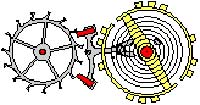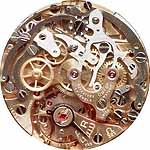Watches & Instruments:
As I understand it, truly dedicated watch collectors would argue that time pieces are not jewelry, but rather little packages of technology. This is so. Personally, I am something of a maritime history buff and find fascination in the story of the invention of the first timepiece that was accurate enough to be used in navigation. I don't often recommend books, but Dava Sobel's LONGITUDE is a must for either students of chronometry or students of ships and the sea. It also provives insight to how technology gets adopted -who wins, who loses, and in this case, who gets screwed. Wonderful book!
But I digress. Watches are a sub-set of instruments -they measure time rather then distance, temperature, light, etc. Antique instruments are ingenious mechanisms, often beautifully and intricately crafted -one-at-a-time even- to solve a new problem. And by a new problem, I mean something needs to be measured that we didn't even know about the day before -things like electricity, or radiation. Or we didn't need to measure something as accurately as we did before. "Cold", "dang cold", or "effing cold" might get it done if we are deciding to wear mittens or not, but for sides of beef coming up from Texas in trucks or box-cars? Someone somewhere along the line had better dang well have had a thermometer of some sort -probably several of then and a recording one would be nice. Particularly if I'm going to be eating the beef.
Something else strikes me about watches and instruments. They all are made out'a math! Often sophisticated math or even fancier geometry. So many teeth on this gear turning that gear with some other number of teeth turns an hour hand thru so many degrees of arc to make it three o'clock. Yet some of these little antique math machines are absolutely artistically beautiful. Or at least compellingly intricate. Steam-punk suggests itself about now, but I leave it to you to sort out, because I need to address....
Preservation:
Can you say fragile boys and girls? Interestingly enough, and from Longitude above, the first time-peace accurate enough to go on old sailing-ships & help with navigation had to be pretty rugged indeed, but for the most part, instruments were expensive and fussy and served by out-putting some math. They could do this by moving a dial or a pointer then taking the rest of the day off. Not quite the same thing as out-putting enough steam to pull a train over the Rocky Mountains.
So instruments are usually pretty fragile. Watches, (portable & ruggedized instruments after all), would work well in simple Drawer-cases, but consider Adaptable Drawer Linings to keep them from sliding around. For really valuable & delicate instruments -especially those with awkward shapes and pointy bits, consider French Lining for Drawers.
You might also want to read up on Desiccants if your instrument has a lot of metal fiddly-bits. For that matter, read about Fabrics too. It turns out you can ruin silver by carefully cushioning it in the wrong fabric -good intentions not-with-standing
Interesting Links:
 International Association of Watch and Clock Collectors This is one SERIOUS bunch of collectors. Impressive web site.
International Association of Watch and Clock Collectors This is one SERIOUS bunch of collectors. Impressive web site.
Watch-Collector's Paradise Another impressive web site -a little friendlier -but more stuff then I had the patience to surf.
Always fascinated me that people fiddled about with the insides of watches. Talk about tiny and fussy. The Watch Guy is such a person and has a great web site.
Abby Clocks has in incredible site with more then you would ever want to know about the workings of watches.
Additionally -a guy named Mark Headrick has a page with animations of Escapements in Motion of a dozen or so different flavors. Amazing


